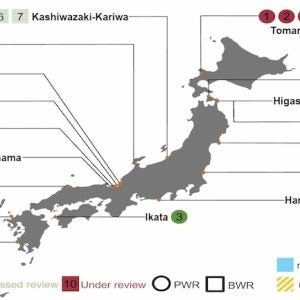An estimated 450 GW+ of fossil, hydro, nuclear, solar, wind energy and carbon capture projects are being planned worldwide over the next decade. As projects go through various phases – feasibility evaluation, proposal, application pending, permitted, site preparation, and construction – some may be discontinued and new projects added. Typically, the total number of projects “in play” exceeds 600.
As soon as a power project is approved, the pressure is on to get multiple parties – the owners, EPC firms, consultants, contractors and suppliers – working together efficiently to meet an aggressive schedule. This challenge is often exacerbated by having globally-dispersed participants and a large volume of data flowing around the project team.
Common tools – such as hard-copy documents, email and installed software solutions – were not created for a collaborative environment, and certainly weren’t designed to cope with the complexities of large-scale projects with hundreds of project members. As a result, these tools can expose organisations to delays in start-up, increased costs, rework and other risks.
An increasing number of projects are using web-based collaboration to deal with such challenges. These systems, delivered by specialist independent vendors for the duration of a development, are being used to link teams and to provide a project-centric system for information management.
The power project environment
Power projects are usually large, long-running, complex, and at times, global. They are typically of very high value and require a high volume of documentation. Capital spending is routinely in the hundreds of millions, often billions, of dollars. Timelines are long and can be influenced by a wide range of internal and external factors such as government review, environmental issues, equipment lead times and financing. Hundreds of organisations and thousands of participants make up the project team, and team members can be spread across several countries.
Power station projects are excellent examples of efforts requiring high levels of documentation and correspondence. Large volumes of documents, drawings, and specifications need to be drafted, submitted, reviewed, revised, approved and released. These can include photographs, GIS maps, drawings, vendor documentation, calculations, geological information, reports, specifications, procedures and schedules. In addition, the volume of formal correspondence items, such as technical queries and requests for information, can amount to hundreds of thousands per project. Even on a relatively small, $200 million, project, this can result in hundreds of thousands of documents including revisions.
As shown in Figure 1, on a typical $200 million power project, the volume of data being exchanged ramps up exponentially, engaging some 270 participants from 40 organisations within the first 18 months.
From the exploratory stages of a given project through to commissioning and commercial operation, the volume of information quickly approaches a high level, as the graph indicates.
Typical examples of specific information generated are shown in Table 1. Clearly, critical information is generated and exchanged at each project stage.
Challenge of accuracy and timeliness
Documentation and formal correspondence are essentially the lifeblood of a project, and the consequences of not controlling this information to a high standard can be significant. Late, inaccurate or even lost documents are often the primary contributor to delays, disputes, rework and litigation. Efficient, accurate information exchange is at the core of successful collaboration; for a project to remain on track, the right people need to access the right information at the right time. Poor decisions, even during the early stages of a project, can result in key milestones being missed, delayed commissioning, unplanned shutdowns, and risks to health, safety and reputation.
The fact that power plant project team members may include organisations and consultants based across several states or even different countries further complicates information exchange. The nature of the work requires highly skilled and specialised organisations to work together, each bringing their own perspective and expertise to bear. The challenge this presents is how best to collaborate when team members are far removed from the project site and from each other.
Adding to the challenge is the high level of staff migration that occurs throughout the life cycle of a typical power project, with team members constantly moving on to new projects. This can create a huge ‘knowledge gap’ if information management processes are weak.
These challenges underscore the need to employ, as an integral part of project delivery, platforms and processes that link team members and reduce exposure to risk.
Traditional document management
Traditional methods of communication, such as hard-copy documents, couriers and email are intended for organisations rather than projects. In a project environment they tend to be unstructured, expensive and man-power-intensive, and can lead to each firm becoming an information silo.
Installed document management systems are undoubtedly effective in managing each organisation’s data, however they are hosted and controlled by one organisation and lack the functionality, transparency and cross-company training and support required for the collaborative environment of a project.
The limitations of traditional information management tools can expose projects, clients and EPCMs to significant risks, as shown in Table 2.
Advantages of on-line collaboration
Any proposed solution aimed at addressing the limitations and risks associated with traditional information management processes must be “project-centric” so that it:
• Provides control over information throughout the project lifecycle.
• Provides an efficient mechanism for storing, managing and exchanging large volumes of documentation and correspondence in real time over the life of an asset.
• Promotes collaboration with external organisations and suppliers that are globally dispersed.
• Guarantees information retention and transparency with an audit trail of transactions.
Business use of web-based tools to support collaboration is nothing new – virtual meetings and CRM systems are widely used to link dispersed individuals and organisations. So it is perfectly logical that the web be used to support communication on complex power projects.
Web-based collaboration systems are increasingly being used to manage project information, link organisations and enable dispersed team members to collaborate in real time. These systems allow organisations working on a project to store and manage documents and formal correspondence on-line, using one secure, central platform. Authorised team members can instantly view, track and distribute their files from any location and at any time. As illustrated in Figure 2, a project-centric on-line collaborative platform eliminates the numerous and diffuse communication channels characteristic of traditional systems.
Project-based vs enterprise systems
The leading on-line collaboration solutions are delivered using the Software as a Service (SaaS) model, whereas enterprise-based document management software is purchased, owned and operated by a single organisation. It is generally recognised that SaaS is a more suitable model for the project environment.
With the SaaS-delivered collaboration system, the independent service provider hosts and operates the application for use by project participants. The paying client (usually one of the lead organisations on the project) pays for the entire project team to use the system. With most leading providers, there are no additional costs, as the fixed fee should cover unlimited access, data hosting, training and ongoing support for all project participants. This model of engagement drives early and consistent uptake across the project, ensuring that data capture is maximised. On-demand delivery means that the solution can be implemented within days.
Hardware and software supply, maintenance, upgrades and risk are all taken on by the service provider, meaning little or no internal IT resource is required. The systems are designed specifically for the requirements of the industry and can easily be configured to meet project needs.
With collaboration systems, data is held by a neutral third party and each organisation has access to (and retains full ownership of) data it has created or received. This can alleviate data ownership issues in joint ventures, where no party wants its information to be held behind another’s firewall.
When assessing solutions for managing data, security should be a primary consideration. Again, the SaaS model is highly suited to the project environment. While installed systems host project information on one organisation’s server, on-line collaboration providers store data in secure and professionally managed production data centres, external to the provider’s offices. These data centres provide physical and environmental security, with measures such as round the clock monitoring, controlled access only by prior arrangement, closed circuit video surveillance inside and out, fire control systems, etc. It is standard practice to keep multiple copies of client data, which is continuously backed up to disaster recovery sites.
Table 3, below, summarises some of the main reasons why SaaS-delivered on-line collaboration systems are considered more suitable for a project than internal document management software:
Although SaaS solutions support the collaborative environment of a project, they are also compatible with installed electronic data management systems. When the project is completed, or earlier if required, participating organisations can upload project data onto their own document management system for future reference. Information can also be held in a secure electronic archive by the collaboration provider. Application programming interfaces (APIs) are increasingly being used to allow project information (including documents and meta data) to be passed to internal enterprise data management platforms when required.
Two power industry perspectives
A number of international firms involved in power project management, consulting and engineering have already realised the value of SaaS as a collaborative solution for power projects. One such is Contour Global, which develops, acquires and operates electric power, combined heat and power, and district heating plants, with 15 power plants on 12 countries. Contour’s senior vice president of engineering & construction, Bill Fox, says: “Each of our projects generates thousands of documents which must be exchanged between internal and external parties. Because team members are often geographically dispersed, we needed a central system that could securely manage our documentation whilst ensuring it was still easily accessible to project participants. [SaaS provider] Aconex offered the best system for our needs as well as extensive expertise in delivering its service to complex, multinational-based projects.”
Arcadis, an international project management, consulting and engineering firm, also selected SaaS provider Aconex for work it is doing on the Nueces Bay Energy Center project in Corpus Christi, Texas. The development involves the demolition of the existing power plant and construction of a natural gas combined cycle facility, due to enter operation this year. Arcadis project manager, Trisha Elizondo, stated, “Aconex will act as a central repository for all of our project documentation so that it can be easily accessed by our dispersed project teams. We anticipate that being able to review and share files instantly on-line will enhance efficiency. Additionally, having an audit trail of all transactions will increase our control and reduce the risk of disputes.”
Web-based collaboration: addressing a core challenge
Summarising, the increasing size of projects and their global spread continue to create opportunities for organisations to work on projects far removed from where they are located. This has presented new challenges in terms of efficiently collaborating with other participating organisations.
A need has emerged for a more transparent, project-centric approach to managing information as traditional, organisation-based tools were not created for an increasingly global collaborative environment. As with many industries, web-based tools are being introduced to provide a system for linking dispersed teams.
Web-based collaboration systems are information management tools that allow parties working on a project to store, track, share, and archive their information using one central, on-line platform. Delivered on-demand for a project’s duration, these systems enable authorised team members to instantly view, track and distribute their files from any location and at any time.
The benefits of these solutions include: saved time due to accelerated access to, and distribution of, data, regardless of location; reduced costs associated with finding, storing and sharing files; and reduced exposure to risks such as information loss, reliance on outdated documents and disputes.
On-line collaboration systems address a core challenge faced by organisations involved with power projects and counter the risk of delay, financial and legal loss that can result from the limitations of more traditional information management tools.






